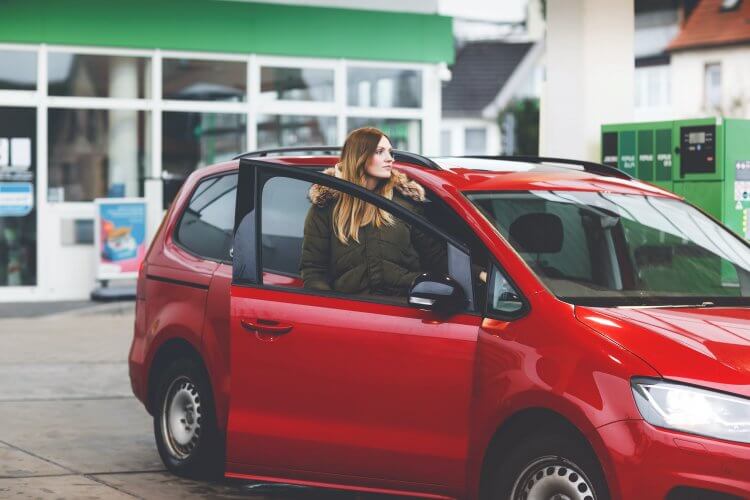
Since we don’t have control over how much gasoline costs at the pump, it’s good to know that there are a few things we can do to stretch out how often we have to fuel up our cars. Here are 10 tips to save on gas that may surprise you.
1. Use Your A/C at Higher Speeds
Many people would say that rolling your windows down for air and turning off your air conditioner (A/C) saves gas. While that can be true at slower speeds, aerodynamic drag rises exponentially once you hit 60 mph and above.
2. Stop Idling
Idling is running a vehicle’s propulsion engine when the vehicle isn’t moving. It not only wastes fuel but it creates harmful emissions. If you find yourself idling, consider these next three ways to avoid it.
3. Turn Right*
Did you know mail and package delivery trucks almost never turn left? UPS saves millions of gallons of fuel each year and avoids emissions equivalent to over 20,000 passenger cars by favoring right-hand turns at all times – unless a left is unavoidable. One reason they do this is to avoid unnecessary idling while waiting to make left turns.
*Note: If you’re going to try this tip out, be sure to do it with a route you already know. Getting lost and making several of the same right turns won’t help you or your gas tank.
4. Warm Up The Engine
Lots of people start their cars in the winter to “warm them up” before getting in. In fact, many newer vehicles come with remote starts allowing you to start your car from inside your home or workplace with a remote on your key or smartphone. But unless your car can take a spin around the block my remote, it may not be doing you, your gas tank, or the environment any favors.
Cars get better fuel economy when the engine is warm, which is achieved by driving, not idling. On cold days, you’re better off getting in and hitting the road. Your car and you will warm up much faster by driving.
5. Just Turn It Off
It only takes about 10 seconds worth of fuel to restart your vehicle, according to fueleconomy.gov. On the other hand, Idling wastes a quarter to a half-gallon of fuel per hour, depending on your engine size and air conditioner use. If you are waiting for someone for an extended time, roll down your windows and shut off your car to save gas.
6. Get Going
Accelerating too slowly can actually waste more gas than speeding up quickly. In a test performed by Popular Mechanics, they found that taking 15 seconds to accelerate to 50 mph used less fuel than taking 30 seconds to reach the same speed because the car entered its top fuel-saving gear sooner.
7. Use Your Cruise Control*
A Natural Resources Canada study found that varying your speed up and down between 75 and 85 km per hour every 18 seconds can increase your fuel use by 20 percent. That means if you stayed at a steady 80 km (49.7 mph) with cruise control versus cycling from 75 to 85 kph (46.6 to 52.8 mph) every 18 seconds, you’d save 20 percent more fuel.
*Note: This tip is most effective on flat terrain. On hills and mountains, you’ll want to allow your speed to drop when you travel uphill, then regain your momentum as you roll downhill.
8. Travel Light
Avoid hauling heavy items when you can, especially if you’re carrying them outside of your vehicle, like on a roof rack. Not only does excess weight in/on your car waste more gas, but items on the outside of your car can also affect your vehicle’s aerodynamics, causing excess drag.
9. Coast to a Stop
Slowly coasting to a red light saves gas while slamming on your brakes wastes it. That’s because you are employing fuel at every second when you wait to brake. When you let go of the gas and slowly come to a stop, you are allowing your car’s weight and motion to do the work, saving gas.
In fact, in a test done by Popular Mechanics, coasting briefly boosted fuel efficiently by more than 50 percent.
10. Keep Your Tires Properly Inflated
Under-inflated tires can lower your vehicle’s gas mileage by about 0.2 percent for every 1 PSI drop in the average pressure of all tires, according to the U.S. Department of Energy. Over-inflating your tires, which many believe can increase mileage, is largely not recommended by manufacturers.
Wondering what PSI is? It stands for “pounds per square inch” of pressure and is the unit your pressure gauge uses to provide readings. Your car’s recommended PSI should be located on the driver’s side door jamb or your owner’s manual.
These surprising tips can help you save on gas. The best way to save on car insurance is to get a free quote from Freeway Insurance. Freeway Insurance can help you shop for the best auto insurance you can get at a price you can afford. Call (800) 777-5620 today to speak to a live agent.



